Capital Budgeting: Investment Valuation, WACC, and Feasibility
VerifiedAdded on 2023/06/10
|7
|1281
|290
Report
AI Summary
This report provides a comprehensive analysis of capital structure and the Weighted Average Cost of Capital (WACC) in the context of investment valuation and capital budgeting. It explains how WACC is determined and its usefulness in evaluating the feasibility of capital projects, recommending project evaluation strategies based on WACC. The report also touches upon the marginal cost of capital and its relevance in investment decisions, using Apex Printing as an example to illustrate the concepts. Desklib offers a wealth of similar solved assignments and study resources for students.
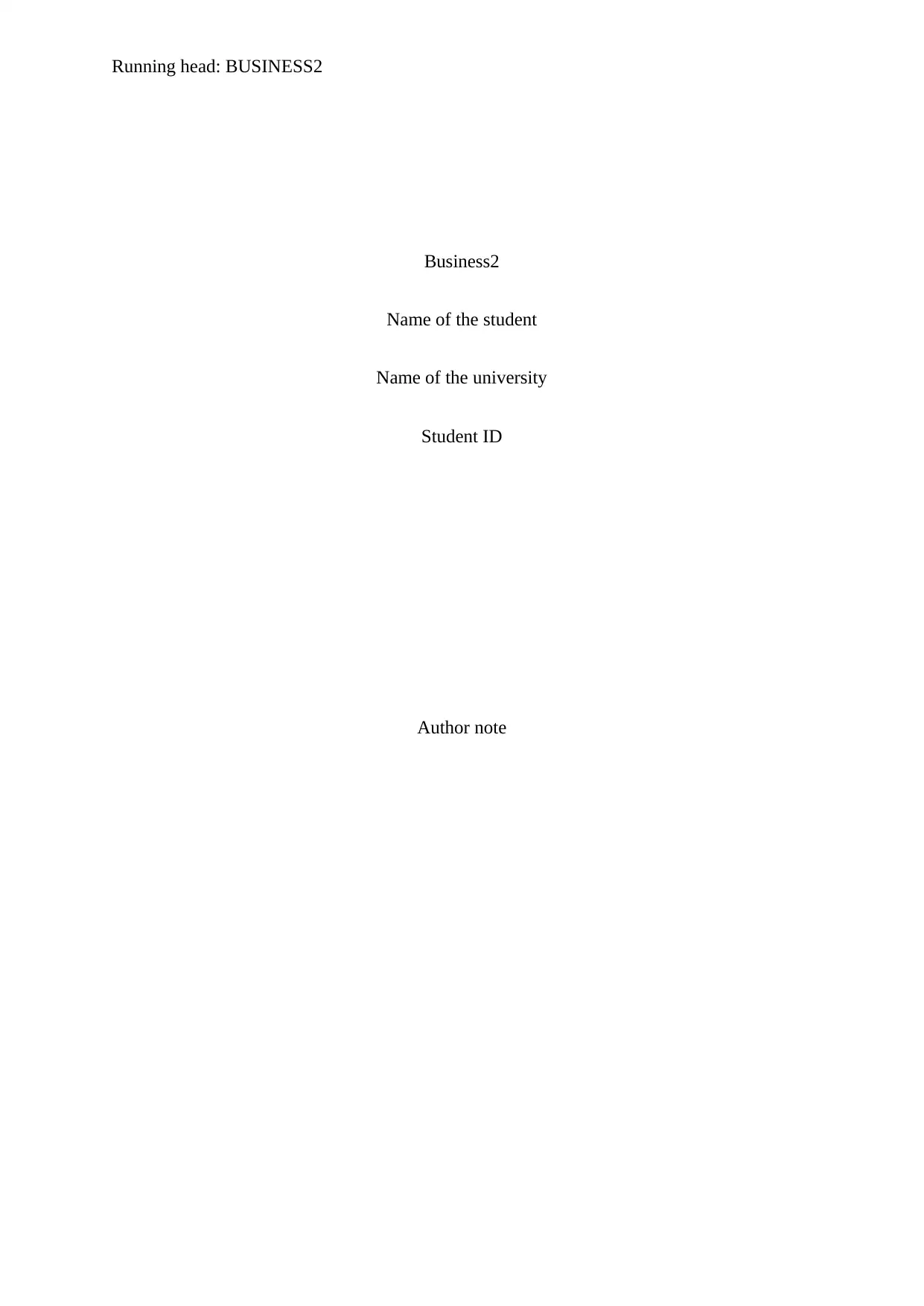
Running head: BUSINESS2
Business2
Name of the student
Name of the university
Student ID
Author note
Business2
Name of the student
Name of the university
Student ID
Author note
Paraphrase This Document
Need a fresh take? Get an instant paraphrase of this document with our AI Paraphraser
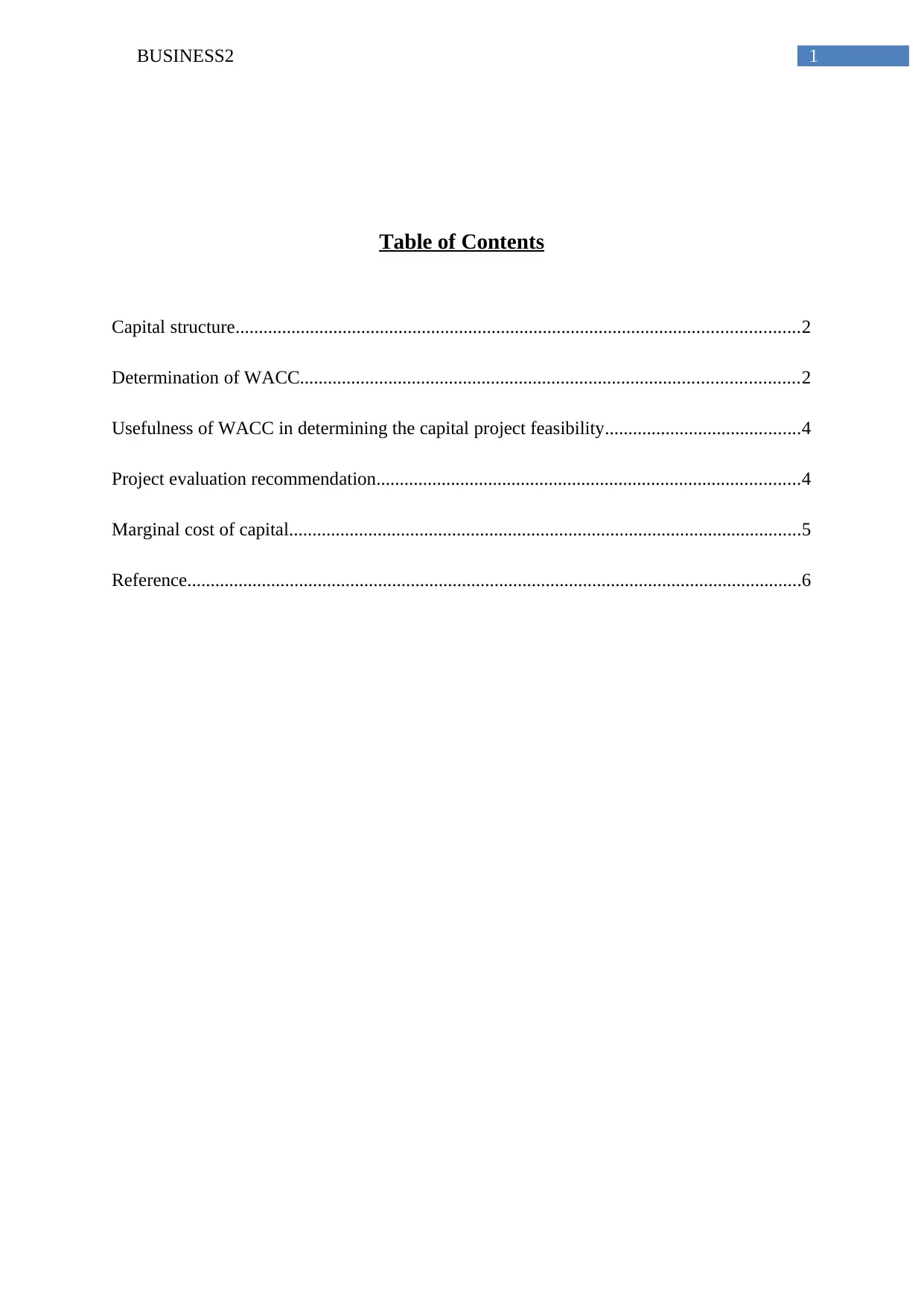
1BUSINESS2
Table of Contents
Capital structure.........................................................................................................................2
Determination of WACC...........................................................................................................2
Usefulness of WACC in determining the capital project feasibility..........................................4
Project evaluation recommendation...........................................................................................4
Marginal cost of capital..............................................................................................................5
Reference....................................................................................................................................6
Table of Contents
Capital structure.........................................................................................................................2
Determination of WACC...........................................................................................................2
Usefulness of WACC in determining the capital project feasibility..........................................4
Project evaluation recommendation...........................................................................................4
Marginal cost of capital..............................................................................................................5
Reference....................................................................................................................................6
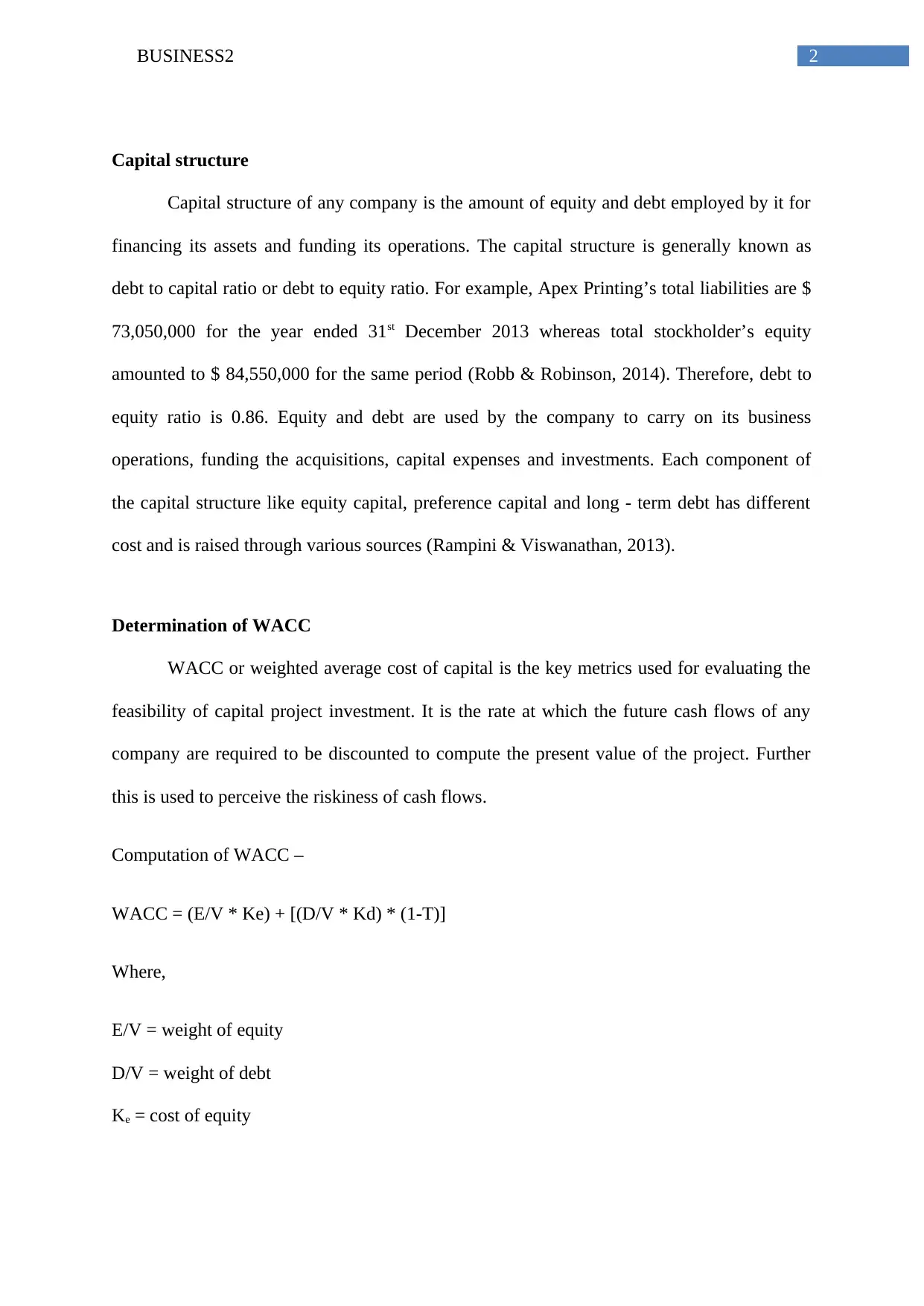
2BUSINESS2
Capital structure
Capital structure of any company is the amount of equity and debt employed by it for
financing its assets and funding its operations. The capital structure is generally known as
debt to capital ratio or debt to equity ratio. For example, Apex Printing’s total liabilities are $
73,050,000 for the year ended 31st December 2013 whereas total stockholder’s equity
amounted to $ 84,550,000 for the same period (Robb & Robinson, 2014). Therefore, debt to
equity ratio is 0.86. Equity and debt are used by the company to carry on its business
operations, funding the acquisitions, capital expenses and investments. Each component of
the capital structure like equity capital, preference capital and long - term debt has different
cost and is raised through various sources (Rampini & Viswanathan, 2013).
Determination of WACC
WACC or weighted average cost of capital is the key metrics used for evaluating the
feasibility of capital project investment. It is the rate at which the future cash flows of any
company are required to be discounted to compute the present value of the project. Further
this is used to perceive the riskiness of cash flows.
Computation of WACC –
WACC = (E/V * Ke) + [(D/V * Kd) * (1-T)]
Where,
E/V = weight of equity
D/V = weight of debt
Ke = cost of equity
Capital structure
Capital structure of any company is the amount of equity and debt employed by it for
financing its assets and funding its operations. The capital structure is generally known as
debt to capital ratio or debt to equity ratio. For example, Apex Printing’s total liabilities are $
73,050,000 for the year ended 31st December 2013 whereas total stockholder’s equity
amounted to $ 84,550,000 for the same period (Robb & Robinson, 2014). Therefore, debt to
equity ratio is 0.86. Equity and debt are used by the company to carry on its business
operations, funding the acquisitions, capital expenses and investments. Each component of
the capital structure like equity capital, preference capital and long - term debt has different
cost and is raised through various sources (Rampini & Viswanathan, 2013).
Determination of WACC
WACC or weighted average cost of capital is the key metrics used for evaluating the
feasibility of capital project investment. It is the rate at which the future cash flows of any
company are required to be discounted to compute the present value of the project. Further
this is used to perceive the riskiness of cash flows.
Computation of WACC –
WACC = (E/V * Ke) + [(D/V * Kd) * (1-T)]
Where,
E/V = weight of equity
D/V = weight of debt
Ke = cost of equity
⊘ This is a preview!⊘
Do you want full access?
Subscribe today to unlock all pages.

Trusted by 1+ million students worldwide
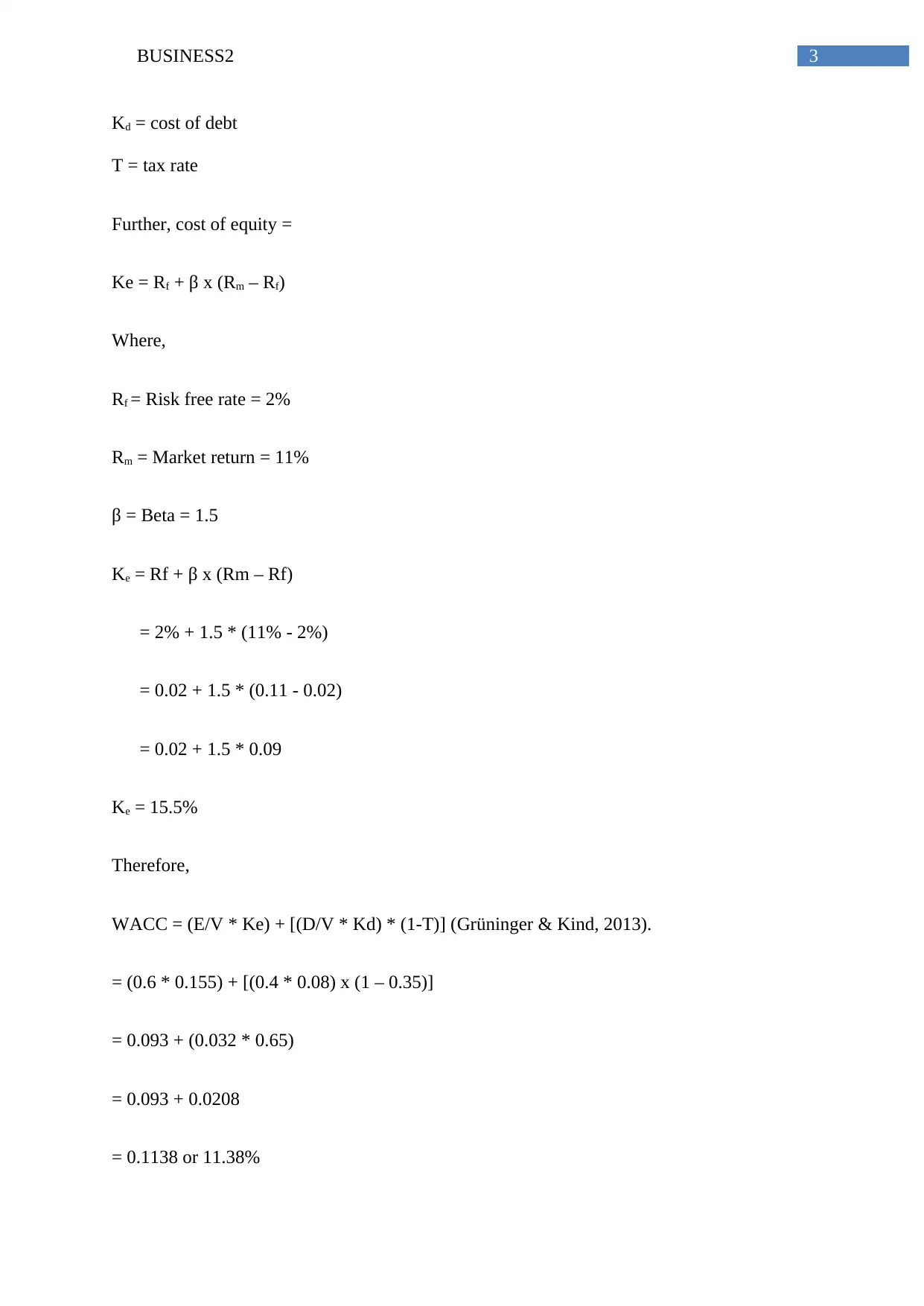
3BUSINESS2
Kd = cost of debt
T = tax rate
Further, cost of equity =
Ke = Rf + β x (Rm – Rf)
Where,
Rf = Risk free rate = 2%
Rm = Market return = 11%
β = Beta = 1.5
Ke = Rf + β x (Rm – Rf)
= 2% + 1.5 * (11% - 2%)
= 0.02 + 1.5 * (0.11 - 0.02)
= 0.02 + 1.5 * 0.09
Ke = 15.5%
Therefore,
WACC = (E/V * Ke) + [(D/V * Kd) * (1-T)] (Grüninger & Kind, 2013).
= (0.6 * 0.155) + [(0.4 * 0.08) x (1 – 0.35)]
= 0.093 + (0.032 * 0.65)
= 0.093 + 0.0208
= 0.1138 or 11.38%
Kd = cost of debt
T = tax rate
Further, cost of equity =
Ke = Rf + β x (Rm – Rf)
Where,
Rf = Risk free rate = 2%
Rm = Market return = 11%
β = Beta = 1.5
Ke = Rf + β x (Rm – Rf)
= 2% + 1.5 * (11% - 2%)
= 0.02 + 1.5 * (0.11 - 0.02)
= 0.02 + 1.5 * 0.09
Ke = 15.5%
Therefore,
WACC = (E/V * Ke) + [(D/V * Kd) * (1-T)] (Grüninger & Kind, 2013).
= (0.6 * 0.155) + [(0.4 * 0.08) x (1 – 0.35)]
= 0.093 + (0.032 * 0.65)
= 0.093 + 0.0208
= 0.1138 or 11.38%
Paraphrase This Document
Need a fresh take? Get an instant paraphrase of this document with our AI Paraphraser
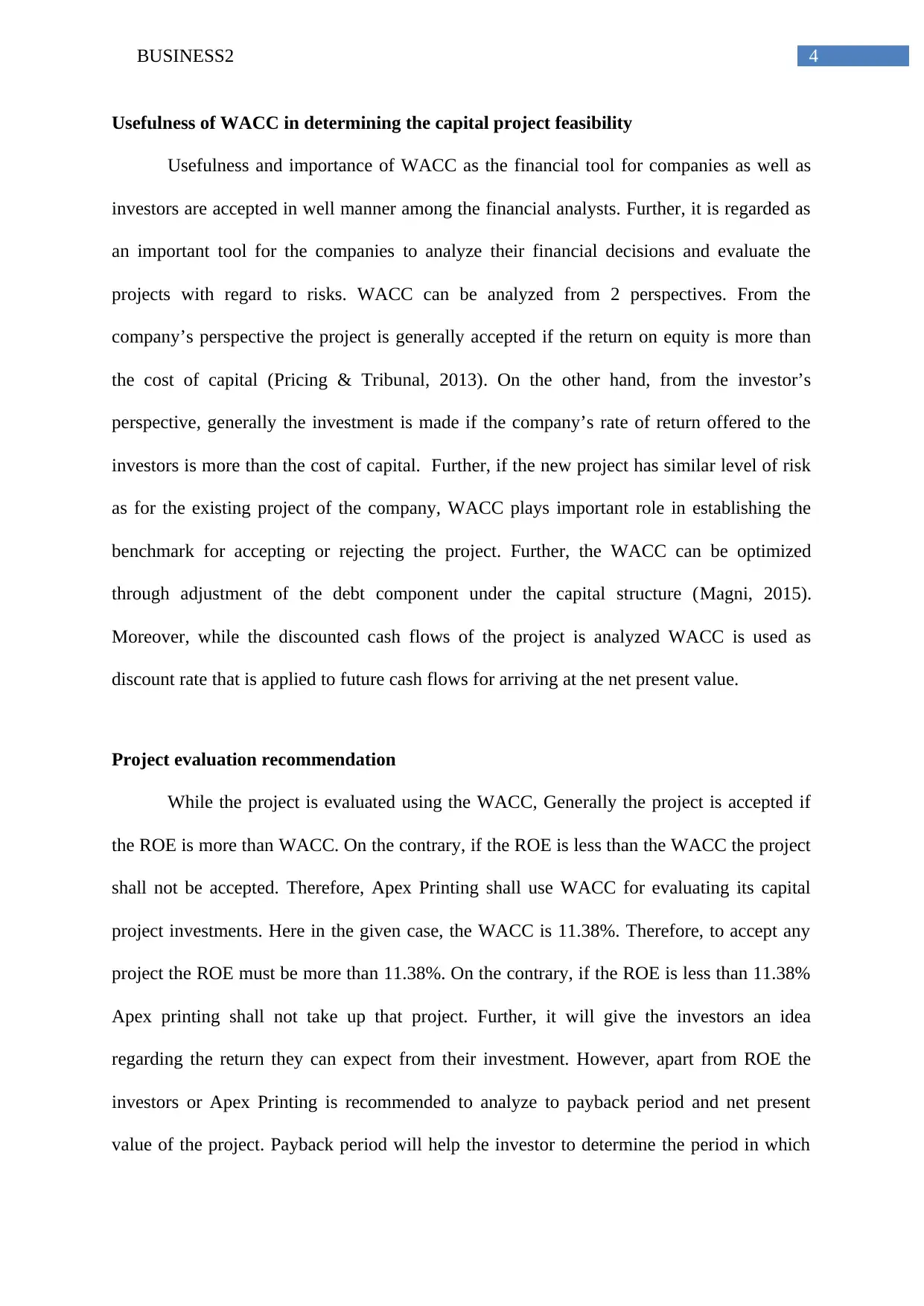
4BUSINESS2
Usefulness of WACC in determining the capital project feasibility
Usefulness and importance of WACC as the financial tool for companies as well as
investors are accepted in well manner among the financial analysts. Further, it is regarded as
an important tool for the companies to analyze their financial decisions and evaluate the
projects with regard to risks. WACC can be analyzed from 2 perspectives. From the
company’s perspective the project is generally accepted if the return on equity is more than
the cost of capital (Pricing & Tribunal, 2013). On the other hand, from the investor’s
perspective, generally the investment is made if the company’s rate of return offered to the
investors is more than the cost of capital. Further, if the new project has similar level of risk
as for the existing project of the company, WACC plays important role in establishing the
benchmark for accepting or rejecting the project. Further, the WACC can be optimized
through adjustment of the debt component under the capital structure (Magni, 2015).
Moreover, while the discounted cash flows of the project is analyzed WACC is used as
discount rate that is applied to future cash flows for arriving at the net present value.
Project evaluation recommendation
While the project is evaluated using the WACC, Generally the project is accepted if
the ROE is more than WACC. On the contrary, if the ROE is less than the WACC the project
shall not be accepted. Therefore, Apex Printing shall use WACC for evaluating its capital
project investments. Here in the given case, the WACC is 11.38%. Therefore, to accept any
project the ROE must be more than 11.38%. On the contrary, if the ROE is less than 11.38%
Apex printing shall not take up that project. Further, it will give the investors an idea
regarding the return they can expect from their investment. However, apart from ROE the
investors or Apex Printing is recommended to analyze to payback period and net present
value of the project. Payback period will help the investor to determine the period in which
Usefulness of WACC in determining the capital project feasibility
Usefulness and importance of WACC as the financial tool for companies as well as
investors are accepted in well manner among the financial analysts. Further, it is regarded as
an important tool for the companies to analyze their financial decisions and evaluate the
projects with regard to risks. WACC can be analyzed from 2 perspectives. From the
company’s perspective the project is generally accepted if the return on equity is more than
the cost of capital (Pricing & Tribunal, 2013). On the other hand, from the investor’s
perspective, generally the investment is made if the company’s rate of return offered to the
investors is more than the cost of capital. Further, if the new project has similar level of risk
as for the existing project of the company, WACC plays important role in establishing the
benchmark for accepting or rejecting the project. Further, the WACC can be optimized
through adjustment of the debt component under the capital structure (Magni, 2015).
Moreover, while the discounted cash flows of the project is analyzed WACC is used as
discount rate that is applied to future cash flows for arriving at the net present value.
Project evaluation recommendation
While the project is evaluated using the WACC, Generally the project is accepted if
the ROE is more than WACC. On the contrary, if the ROE is less than the WACC the project
shall not be accepted. Therefore, Apex Printing shall use WACC for evaluating its capital
project investments. Here in the given case, the WACC is 11.38%. Therefore, to accept any
project the ROE must be more than 11.38%. On the contrary, if the ROE is less than 11.38%
Apex printing shall not take up that project. Further, it will give the investors an idea
regarding the return they can expect from their investment. However, apart from ROE the
investors or Apex Printing is recommended to analyze to payback period and net present
value of the project. Payback period will help the investor to determine the period in which

5BUSINESS2
the investment will be recovered and the net present value will help to determine the present
value of the future cash flows that will be generated from the project
Marginal cost of capital
Marginal cost of capital is the cost required for raising additional one unit of the
capital. It is composite rate for the return that is required by the debt holders and shareholders
to finance new investments in company (Eckles, Hoyt & Miller, 2014). However, it differs
with the average capital cost that is the based on cost of debt and equity that is already issued.
If more capital is raised by the company it will increase the company’s cost of capital as like
any other production factor the capital is scarce and therefore shall be compensated with
higher rate of required return. Return available from the new project shall be compared with
marginal cost of capital and the project is accepted when expected return is higher as
compared to the required return (Drury, 2013).
the investment will be recovered and the net present value will help to determine the present
value of the future cash flows that will be generated from the project
Marginal cost of capital
Marginal cost of capital is the cost required for raising additional one unit of the
capital. It is composite rate for the return that is required by the debt holders and shareholders
to finance new investments in company (Eckles, Hoyt & Miller, 2014). However, it differs
with the average capital cost that is the based on cost of debt and equity that is already issued.
If more capital is raised by the company it will increase the company’s cost of capital as like
any other production factor the capital is scarce and therefore shall be compensated with
higher rate of required return. Return available from the new project shall be compared with
marginal cost of capital and the project is accepted when expected return is higher as
compared to the required return (Drury, 2013).
⊘ This is a preview!⊘
Do you want full access?
Subscribe today to unlock all pages.

Trusted by 1+ million students worldwide
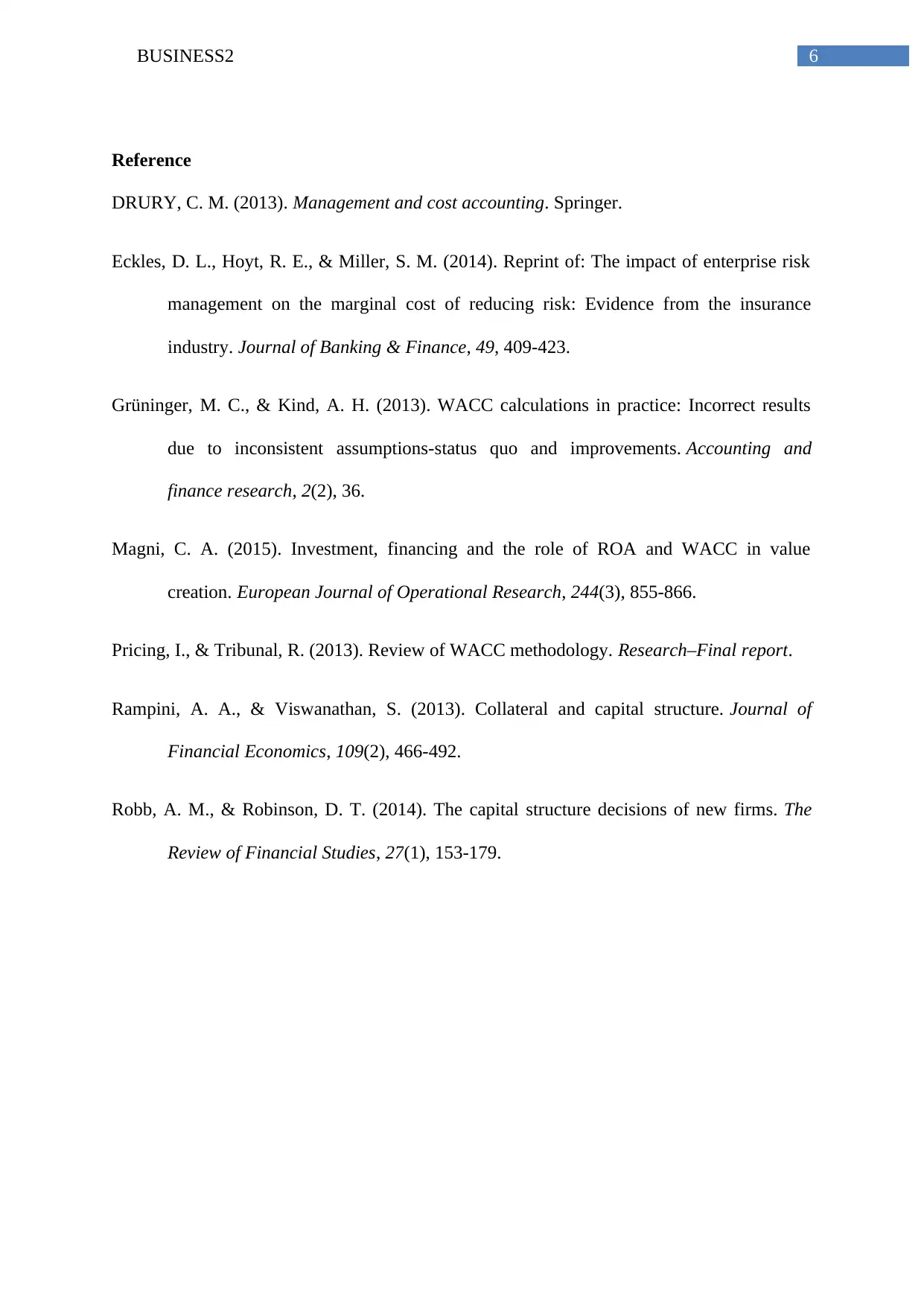
6BUSINESS2
Reference
DRURY, C. M. (2013). Management and cost accounting. Springer.
Eckles, D. L., Hoyt, R. E., & Miller, S. M. (2014). Reprint of: The impact of enterprise risk
management on the marginal cost of reducing risk: Evidence from the insurance
industry. Journal of Banking & Finance, 49, 409-423.
Grüninger, M. C., & Kind, A. H. (2013). WACC calculations in practice: Incorrect results
due to inconsistent assumptions-status quo and improvements. Accounting and
finance research, 2(2), 36.
Magni, C. A. (2015). Investment, financing and the role of ROA and WACC in value
creation. European Journal of Operational Research, 244(3), 855-866.
Pricing, I., & Tribunal, R. (2013). Review of WACC methodology. Research–Final report.
Rampini, A. A., & Viswanathan, S. (2013). Collateral and capital structure. Journal of
Financial Economics, 109(2), 466-492.
Robb, A. M., & Robinson, D. T. (2014). The capital structure decisions of new firms. The
Review of Financial Studies, 27(1), 153-179.
Reference
DRURY, C. M. (2013). Management and cost accounting. Springer.
Eckles, D. L., Hoyt, R. E., & Miller, S. M. (2014). Reprint of: The impact of enterprise risk
management on the marginal cost of reducing risk: Evidence from the insurance
industry. Journal of Banking & Finance, 49, 409-423.
Grüninger, M. C., & Kind, A. H. (2013). WACC calculations in practice: Incorrect results
due to inconsistent assumptions-status quo and improvements. Accounting and
finance research, 2(2), 36.
Magni, C. A. (2015). Investment, financing and the role of ROA and WACC in value
creation. European Journal of Operational Research, 244(3), 855-866.
Pricing, I., & Tribunal, R. (2013). Review of WACC methodology. Research–Final report.
Rampini, A. A., & Viswanathan, S. (2013). Collateral and capital structure. Journal of
Financial Economics, 109(2), 466-492.
Robb, A. M., & Robinson, D. T. (2014). The capital structure decisions of new firms. The
Review of Financial Studies, 27(1), 153-179.
1 out of 7
Related Documents
Your All-in-One AI-Powered Toolkit for Academic Success.
+13062052269
info@desklib.com
Available 24*7 on WhatsApp / Email
![[object Object]](/_next/static/media/star-bottom.7253800d.svg)
Unlock your academic potential
Copyright © 2020–2025 A2Z Services. All Rights Reserved. Developed and managed by ZUCOL.





